The Stadler GTW 2/6 EMU from Piko (Article 40222) has a Veolia Transport livery, and runs in the Netherlands.
I’ve temporarily put aside my digitalization of the “Donald Duck” BR403 (blog post here) to handle something much easier: inaugurating my latest EMU acquisition. The presence of a Plux-12 DCC plug was supposed to make things easier… it didn’t, and here is why.
The original (and a bit of nostalgia)
Stadler is a Swiss-based company, they have an extensive range of EMUs and light rail vehicles.
I thought this EMU was part of the Flirt range, a “standard” platform that can be declined in 2 to 5 car units. The Stadler website is very well done, so I advise giving a quick look at the Flirt Series page here.
I happen to already have two Flirts. One from Liliput (a 5 car model with Deutsche Bahn livery), and another from Modellbahn-Union (a 4-car version, based on the Liliput model, but painted in a grey livery for a private German company).
I started looking for my model here, and couldn’t find it…for a good reason: this EMU, though it bears striking similarity with the Flirt series, belongs to another family: the GTW family.
The GTW family (details here) seems to be even better adapted to local transportation. Stadler’s description emphasizes on smaller clearing gauges, and more lightweight vehicules; this seems to be the main difference with the Flirt family. In fact, GTW stands for “GelenkTriebWagen” (Articulated Joint Railcar).
In any case, what I find very interesting in the GTW 2/6 design (2 cars, 6 axles) is the central motor part of the vehicle, standing on its own bogie. I hadn’t seen such a vehicule until now except…in the “Airport Monorail” from Lego that I had more than 14 years ago. Doesn’t it looks like a rip-off of the Deutsche Bahn red GTW 2/6? 😉
Anyway, this GTW 2/6 is run by Veolia Transport (see here on Flickr for a real-life picture) and serves as a regional train in the Netherlands. For my French friends, Veolia is mostly known for its main activity, “Veolia Environment”, dealing for example with water supply. Veolia Transport is a branch of Veolia Environment, but not a small one. According to Wikipedia, they have more than 72,000 employees worldwide, and run trains in Europe, the US and Israel.
The Stadler website says Veolia Transport Netherlands bought 8 of those EMUs, and several of the same model with diesel traction.
The model
Taking it out of the box, this little train is heavy. So unusually heavy that I actually weighed it: 195g; that’s only a little less than the 5-car Flirt from Liliput !
There a simple explanation, the entire train is in metal. That’s the first time I encounter such a model, and that’s something I didn’t expect for a reasonably priced model (€185). It doesn’t make much different from an esthetic perspective (frankly I couldn’t tell that it wasn’t plastic when I bought it), but it sure feels serious and solid.
Another specificity of this model (and corresponding DB models also released by Piko), is that they are über-motorized. This little EMU packs 2 motors, each located at the extremities. Is that too much? Probably, but I am guessing they are planning on releasing models with more cars and that it was cheaper to come up with a standard mold design (edit: yep, they just released a 3-car model).
So in total, there are 4 powered axles. Each power bogie has 2 wheels with rubber bands, and 2 wheels that get current off the track. Added to this, the central (unmotorized) bogie takes power on all 4 wheels. This EMU should behave perfectly:
Plux-12: here comes trouble
For a DCC conversion, there is no awkward opening of the main case, just a small opening to unscrew at the bottom:
The little analog circuit board shown here has a small switch, in case analog hobbyists wish to turn off the interior lighting. A nice plus.
Because of the solid metal construction, and the fact that the Plux-12 plug is in a closed “black box” at the bottom of the EMU, I decided to not try and fit this model with a sound decoder. I was a bit disappointed at first, but looking on the bright side, I saved about €80 !
In a recent post, I complained about the new DCC plug types. This model happens to have a Plux-12 digital connector. It also confirms one of my fears: not only are there many “norms”, but the manufacturers don’t even respect whichever one they pick.
The (non biding) NEM 658 paper asks to leave a precise space for the Plux-12 decoder: an area of 20x11mm. So far so good, this models happens to be respecting this norm exactly.
The problem is, for some reason, the Plux-12 connector is supposed to be located slightly on the left:

Plux-12 connector from the official NEM 658.
So what’s wrong? While Piko respected the decoder space requirement to the letter, they decided to put the connector in the center, and not slightly on the right (for a decoder plug slightly on the left). That means any decoder designed to fully spread and fit to standard Plux12 space won’t work. The decoder needs to be less than 11mm wide.
There are not so many Plux-12 decoders around:
- The “official” Piko decoder 46211 – but at nearly €60, I don’t think so!
Besides, according to what I have read, this is just a rebranded Uhlenrbock decoder. - The Uhlenbrock 73140, which at €30 seems more reasonable.
The problem with the above decoders is that they don’t have Railcom. I like Railcom for Programming on the Main (see my post about Railcom here), so I looked for other options:
- ESU (my “favorite brand”) has a Plux12 model, but only with a cable (I need a direct connector).
- The Lenz Silver+ Plux 12 10312-01
Lenz is a good brand (and the creator of Railcom). Sadly, this decoder is exactly as big as what the norm requires: 20x11mm. Sadly as well, they DO respect the norm to 100%: the connector is not centered, it won’t fit in the Stadler. - The Zimo MX623 (this new model doesn’t appear on the English website yet)
I have many Zimo decoders. When I lived in Brussels, the owner of my favorite hobby shop recommended them, and I never had any problems.
The good news about this decoder: it is long (20mm, the exact norm), but it is less wide (8,5 mm), which means it may fit in my ill-conceived Plux-12 connector.
I took a leap of faith – hoping Piko at least correctly placed the plug vertically – and ordered this decoder.
Fitting the decoder in
After receiving the decoder, I realized Piko had not just disrespected the horizontal, but also the vertical space requirements specs. The Zimo decoder is exactly 2 cm long…but somehow, it doesn’t fit:
Fortunately, there was just a 1/2mm overlap. I was able to gently force the decoder in (partially, but enough). I then screwed the plastic piece back on the top, hoping I wouldn’t push further (and break) the decoder pins.
I haven’t used Zimo decoders for a while, I like the comfort of programming my decoders (usually ESU) from their PC software. But the ESU ECOS II command station makes things easy. It took a minute to update the important CVs (address, function addresses for slow speed modus…). I am glad I searched hard for a Railcom compatible decoder; thanks to direct programming on the main track, I was able to adapt the speed CVs (max speed…) in 5 minutes while having the train test-run on my layout.
Conclusion
I am annoyed by the Plux-12 issues; but it’s also important to remember the advantage of this new plug. In this model for example, interior lighting can be switched independently from headlights. I can’t say that is a killer app, but it’s nice to have.
This Stadler runs very smoothly, and has no problem climbing up with its two motors. I still need to play further with the advanced decoder setting to make sure the train runs smoothly at lower speed.
The less than €200 price tag sounds very reasonable to me, and I don’t regret my purchase; make sure to check the quick video at the top of this post.
Update 2013-12 on the MX623P12 decoder and high track voltage:
Thanks to the comments of a user on the French version of this blog, it now seems clear some MX623P12 decoders from Zimo may have a construction problem. They are overly sensitive to higher track voltage. The reader had his MX623P12 burn out when using it with a Märklin MS2 controller (which is known to deliver a high 18V, unless you change the default power adapter).
In any case, Zimo seems to recommend checking that CV#112 is set to 0.
External links
- The official Veolia/Stadler PDF description http://www.stadlerrail.com/media/uploads/factsheets/GTW_Veolia_EMU_01_e.pdf
- The AMW/Arnold Hübsch website were I got my Zimo decoder for a good price: http://amw.huebsch.at




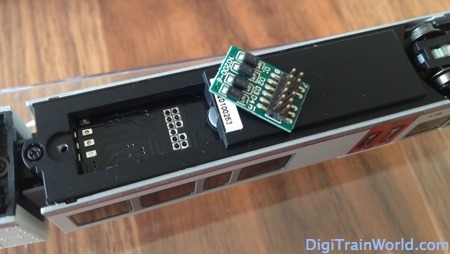
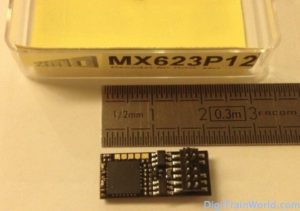
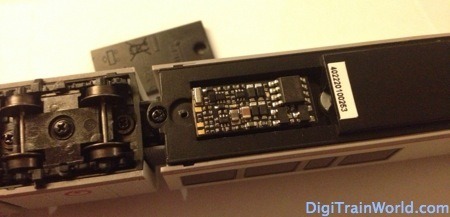
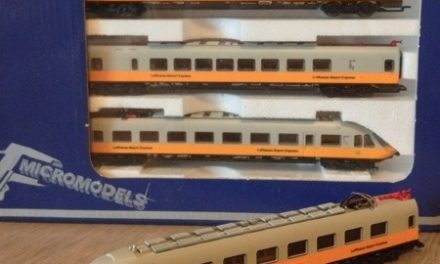

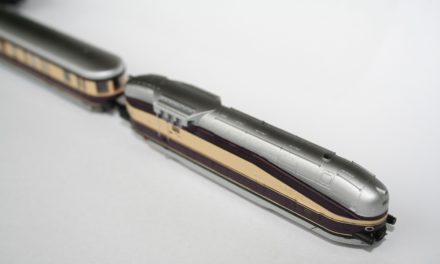
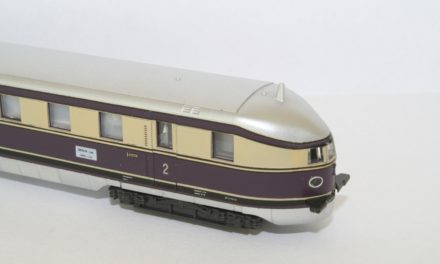


Outstanding review! Very thorough! And I really appreciate your honest assessment of the new Plux 12 “standard”. Unfortunately, as you noted on your earlier post, the new standards are creating more problems which will annoy and frustrate all but the die-hard hobbyists. Too bad. But I appreciate you documenting the issues you had with the Plux 12, so at least now others (potentially myself) can get the right one!
And yes, Zimo’s distribution system is strange! For US modellers, I’m aware of one online shop that carries Zimo (although they appear to be out of stock at the moment of most decoders) and that is DCCtrain: http://www.dcctrain.com/shop/category.aspx?catid=28&page=1
Thanks Jerry, and also for the link for US modellers.
Prices in USD are pretty high though, no matter how good these new plugs are or not, it’s sad that they are a EU-only (or German really) endeavor.
Hi Pierre! Good article (as ever)!
I’ve just purchased a PIKO BR440 “Coradia” which also has Plux12 connector for DCC, and I have several doubts…
After reading the instructions sheet, it’s possible to put sound in this model, but… the problem is that PIKO sells a Plux12 decoder and a sound module (with SUSI plug). I’ve read about this decoder here and I also want to have RailCom, so the solution for me is one of these:
1) ZIMO MX623P12 and the PIKO sound module (about 30+80=110 €). Possible problems: The space for ZIMO decoder is about 2 cm long (could not fit as it happened with your train), and I don’t know how this sound module will work…
2) ESU LokSound Micro 4 with Plux12 connector. Possible problems: it will not fit in the floor space of the train, and I would need to cut a bit the metal chassis. And I don’t know if it’s possible to purchase this decoder with the correct/desired sound mounted in.
As you see, lots of doubts/questions… 🙂 What do you recommend?
Thanks for your help and best regards!
Hi José, it’s a hard question. I think whatever you do, fitting everything is going to be a challenge. I decided not to install sound for this reason.
If you do want sound, I am personally an ESU aficionado. Go to ESU.eu and check if there is a sound project that matches. Some stores (eg http://www.modellbahnshop-lippe.com I think) can offer to load a sound project for you. Personally, I bought the ESU Lokprogrammer, it’s a one-time investment and then you can do anything you want with your decoders. For the Piko, I guess you would need to 1) make a hole between the decoder area and the body of the train 2) cut the Plux12 cable 3) Insert the cable through the hole 4) Solder the plux12 plug back.
Hi Pierre, thanks for your comments. The hole is already made in the body of train, but yes, I would need to cut the Plux12 cable and solder it again. Another option is to cut a part of plastic near the hole and pass the cables without cutting them.
I thought in ESU LokProgrammer, but maybe is too expensive for me, I don’t use such a quantity of ESU decoders. I also buy in MBS Lippe, but didn’t know they could load a sound project with the decoder. Thanks for help!
Interesting, so this Piko model is indeed better prepared for sound than mine!
Remember: I haven’t tried the decoder + SUSI sound module solution. I am sure it can work, I just like to have things “integrated” whenever possible. I also like to add my custom station announcements and sounds, which is relatively easy with the Lokprogrammer.
For the ESU ones, I *think* that MSL can load a sound project for you, but I am not sure. I know some stores do this. Mine in Brussels did this (you bought the “empty” Loksound Micro, gave him a sound project number, he would download it from esu, load it for free on the decoder – it took 10-15 minutes); maybe you are lucky and have such a good store around you?
In any case, be careful with train sound. It is a unnecessary gadget according to many, but it’s an addictive one if you ask me 😉
BTW: I will likely order the track bed you advise on your website soon (lokliege.de), thanks a lot for the tip!
Hi again José,
I wanted to comment on your great blog, but it asks me to create a public Google+ profile. I am sorry I don’t like that 😉
Many many thanks for your advice on the track bed from lokliege.de
I have received my first order and it’s so much better than cork!
I also like their 50x100cm plate, which is really cheap. Surprisingly, the material is different from the normal track bed parts (it’s a foam), but they go perfectly together.
You made the building process of my new fiddle yard much easier and better!!